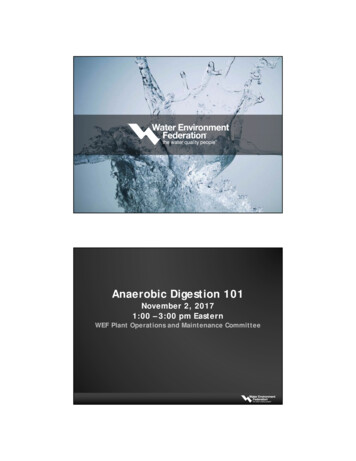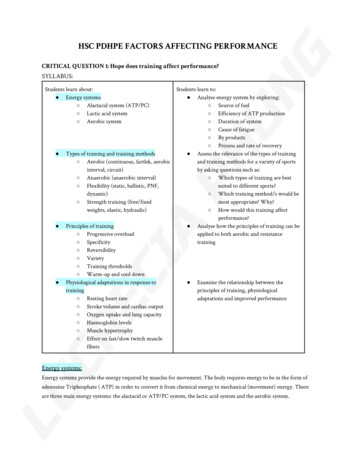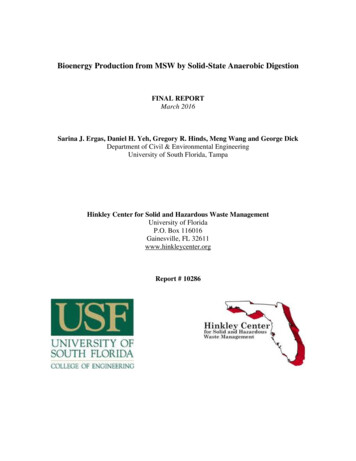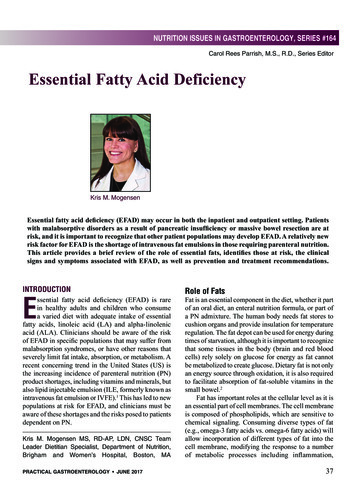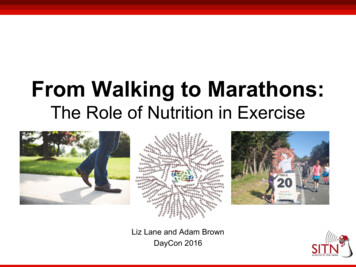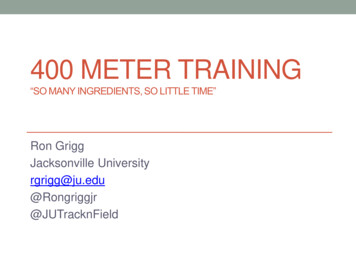
Transcription
Anaerobic Co-Digestion onDairies in Washington StateThe solid waste handling permitexemptionWA S H I N G T O N S TAT E U N I V E R S I T Y E X T E N S I O N FA C T S H E E T F S 0 4 0 EAnaerobic Digestion and the Role ofCo-DigestionThis factsheet briefly reviews the role of co-digestionwithin anaerobic digestion (AD), explains the potentialregulatory concerns, and details the solid waste handlingpermit exemption conditions. An overview of other majorregulatory requirements for AD facilities operating ondairies is also provided.Anaerobic digestion is increasingly used to treat livestockmanure on concentrated animal-feeding operations(CAFOs) across the United States. An AD system createsan environment without oxygen (anaerobic) in whichnaturally occurring microorganisms convert complexorganic materials in manure and other feedstock tomethane-rich biogas, a source of renewable energy (US-EPA2006) (Figure 1).Anaerobic digestion facilities that digest dairy manurehave begun to co-digest pre-consumer organic wastes(such as food-processing wastes) to increase biogasproductivity, improve digester performance, and increaserevenue. Legislation passed in Washington state in 2009provides that AD operations located on or near dairiesthat co-digest organic wastes with manure may qualifyfor an exemption from obtaining a solid waste handlingpermit provided they follow specified guidelines designedto address nutrient management and other potentialconcerns. Co-digestion that is not in compliance with therequirements could jeopardize the digester’s conditionalexemption from a solid waste handling permit or obligatethe Washington State Department of Ecology (“Ecology”)to regulate the dairy farm as a solid waste disposal site.Typical residence times in standard manure and municipaldigesters are on the order of 15–25 days. The process iscarried out at a controlled temperature, usually 35 C or55 C (95 F or 131 F) with increased temperature allowingfor lower residence times.The process can reduce greenhouse gas (GHG) emissions,diminish odors, stabilize waste, and decrease pathogencounts (Martin and Roos 2007; US-EPA 2004; US-EPA 2005;US-EPA 2008). In addition to biogas, AD generates fiber andFigure 1. Overview of anaerobic digestion.1
a liquid effluent. With additional processing, the fiber canbecome a peat-moss replacement suitable for the nurseryand horticultural industries (U.S. Patent and TrademarkOffice 2006).400% (Alatriste-Mondragon et al. 2006; Braun et al. 2003).An economic analysis of an AD facility installed on a700-cow dairy in northwest Washington state showed thatco-digestion with 16% organic wastes more than doubledbiogas production and almost quadrupled annual digesterrevenues compared to a manure-only baseline, with 72%of all receipts directly attributable to the addition oforganic wastes (Bishop and Shumway 2009; Frear et al. insubmission). It is also possible that, in the future, digesterowners who co-digest organic wastes will be able to earnincome through additional GHG emissions offset credits.Meanwhile, ongoing research aims to concentrate thenutrient-rich liquid effluent into fertilizer products(U.S. Patent and Trademark Office 2009; 2011). Thesebyproducts have the potential to provide additional GHGmitigation, enhance revenues, solve nutrient-overloadissues, and increase AD adoption rates.As technologies have matured, many AD projects havebegun to co-digest pre-consumer food-processing wasteswith the manure—a process that has been shown toenhance digester performance and notably increasebiogas production (Frear et al. 2009). If the organic wasteswould have otherwise been landfilled, co-digestion mayalso create additional reductions in GHG emissions bycollecting methane (a powerful GHG).Concerns with Co-DigestionAlthough co-digestion can provide operational,environmental, and economic benefits, organic wastes doresult in an import of additional nutrients to the farm,where they can exacerbate existing nutrient managementconcerns. Most dairies manage the nutrients in manure(or digester effluent) by applying it to land, where thenutrients are taken up by crops. In Washington state, alllicensed dairies operate under nutrient management plans(NMPs) that ensure nutrients are fully used by crops anddo not degrade water quality. Analysis of national datasuggests that in the year 2000, roughly 75% of dairies withmore than 300 animal units (AU) were spreading manureat rates in excess of crop nitrogen needs, and roughly96% were spreading manure at rates in excess of cropphosphorous needs (Ribaudo et al. 2003). More recent dataindicate that larger operations apply manure to croplandat rates that are more than three times higher than smallerfarms, suggesting that excess nutrient applications are stillan issue, particularly for large operations (MacDonald andMcBride 2009).As a result of the benefits that AD provides, more than135 dairy farms nationwide were operating digesters as ofApril 2011 (US-EPA 2011). In total, these digesters wereprocessing manure from approximately 266,000 wet cowequivalents (WCE), providing an installed generatingcapacity of 52.8 megawatts (MW) of electricity, andreducing GHG emissions by more than 860,000 metrictons (MT) of carbon dioxide equivalent per year (CO2e/yr) (U.S. EPA 2011). In Washington state, the six dairyanaerobic digesters operating in 2011 were processingmanure from approximately 11,650 WCE, providing aninstalled generating capacity of 4.05 MW, and reducingGHG emissions by 44,870 MT CO2e/yr (C. Kruger, personalcommunication; US-EPA 2011).Case study evidence that co-digestion can magnify nutrientmanagement issues is available from research completed ata Washington state dairy. Co-digestion with organic wastescaused total nitrogen increases of 57% compared to baselineAD operations, with smaller increases in ammonia andphosphorous (Figure 2) (Frear et al. 2010).A wet cow equivalent (WCE) is defined asa mature milking Holstein with a dry matterintake of 53 lbs or more per day. Dry cows andheifers that are 18 months or older account forapproximately 0.5 WCEs each.There are also concerns that contaminants (such asmaterials containing prions) or pathogens arrivingwith the organic wastes could inhibit the AD process,limit the use of AD products, or create a possibility fornegative public health impacts. Many national and stategovernments are in the process of developing laws, rules,and guidelines to govern co-digestion (Washington StateDepartment of Ecology 2009).The CO2e, or carbon dioxide equivalent,expresses the total global warming potential interms of the radiative forcing of CO2. CO2e isthe international standard used to express GHGemissions or emissions reductions across all GHGs.MT metric ton (1 MT 1 Mg 1,000 kg).The Economics of Co-DigestionWashington’s Dairy Digester Legislation:Solid Waste Handling Permit Exemptionfor Dairy Co-Digestion FacilitiesCo-digestion significantly enhances AD project economicsthrough additional biogas production and tippingfees paid by the generator of the organic wastes to thedigester owner. Various commercial- and laboratoryscale studies have shown that, depending upon the type,concentration, and flow rate of the organic wastes used,biogas production can be enhanced by as much as 25%–In Washington state, Ecology and local health departmentshave regulatory oversight for AD co-digestion facilitiesunder the solid waste statutes. Legislation passed in 2009(RCW 70.95.330) provides a solid waste handling permitexemption for some anaerobic digesters located on or neardairies that co-digest pre-consumer organic wastes withmanure. This exemption applies only to dairy manure2
Figure 2. Modeled nutrient impacts of co-digestion with 16% organic wastes on a dairy in northwest Washington.co-digestion facilities. It does not apply to other farmoperations, even when their NMPs include all the sameelements. Non-dairy AD facilities will need to obtain a solidwaste handling permit from their local health department inorder to import organic wastes for co-digestion.Local health departments include city, county,city-county, or district public health departments.For a map and contact information for local healthdepartments in the state of Washington, seehttp://www.doh.wa.gov/LHJMap/LHJMAP.htm.To qualify for the solid waste handling permit exemption,operators must meet certain conditions, including thefollowing:8. Ecology or local health department inspections areallowed.1. Notice of intent to operate is filed with Ecology orthe local health department at least 30 days beforestartup http://www.ecy.wa.gov/biblio/ecy070356.html.2. The NMP is current (see below).3. Only the specified pre-consumer organic materialsare co-digested, and these materials make up 30%or less of the digester feedstock.4. Digester feedstock and digestate are handled in amanner that protects surface and ground water andcontrols nuisance odors and vectors.5. Digested solids can be:a. returned to the dairy and managed under theupdated NMP,b. sent off-site after passing compost qualitystandards,c. sent to a permitted or conditionally exemptcompost facility, ord. managed in an alternate manner approved byEcology.6. Digested liquids can be:a. returned to the dairy and managed under theupdated NMP, orb. managed in an alternate manner approved byEcology.7. An annual report is submitted to Ecology or thelocal health department ic details on the exemption requirements arecomprehensively described in “Guidelines for Operating anAnaerobic Digester Exempted From Solid Waste HandlingPermit” published by Ecology (WSDOE 2009) and availableat http://www.ecy.wa.gov/biblio/0907029.html.Ecology provides oversight for exempted AD facilities,while the Washington State Department of Agriculture(WSDA) provides oversight for dairy operations andensures compliance with nutrient managementrequirements. The two agencies communicate as neededto ensure that requirements for AD facilities are met. ADowners or operators should contact Ecology to determinewhether their operation can qualify for the solid wastehandling permit exemption.Digestate is defined in RCW 70.95.330 as bothsolid and liquid substances that remain followinganaerobic digestion of organic material in ananaerobic digester.For more related definitions, visit http://apps.leg.wa.gov/rcw/default.aspx?cite 70.95.330.3
Other legislation provides tax exemptions for digesterconstruction, maintenance, and repair. Refer to RCW82.08.900 for details.Nutrient Management Plan Update To retain a solid waste handling permit exemption forboth the digester operation and the dairy, any dairy farmsplanning to implement co-digestion must have their NMPupdated to describe the way manure, organic wastes, andsubsequent digestate will be properly collected, stored,transported, and utilized. Plans must be developed bya nutrient management planner, approved by the localconservation district, and verified by WSDA. The plan must identify any changes in farm-levelnutrient balance that will occur from imported feedstock,and specify how the additional nutrients will be used.Alternatively, when the digester and dairy are separateoperations, the plan can identify limits on digestatevolume sent back to the dairy. In this case, the contractbetween the digester and the dairy should detail thedigestate volumes that can be returned to the dairy.records verifying that the NMP is being followed.These records can also show that discharges are notoccurring, thus avoiding the need for water qualitypermits. More information can be found at ocal or county planning agency requirementsfor the planned anaerobic digesters must besatisfied. Requirements may include permitapprovals for building, grading, water systems,shorelines, right-of-way, utilities, site plans, septicsystems, floodplains, zoning, and others. Checkwith your local government for more details.The State Environmental Policy Act (SEPA) mayrequire review of the environmental impacts ofthe planned digester by a local or state agency(Chapter 43.21C RCW). State policy requiresstate and local agencies to consider the likelyenvironmental consequences of the decisions theymake, including decisions to approve or denylicense applications or permit proposals. Findadditional information at tml.Contact InformationOther Anaerobic Digester Permits andRegulationsWashington state dairy producers and AD operators cancontact the following agencies for more information:All AD facilities, including those that incorporateco-digestion, must operate in compliance with allapplicable regulations. The Washington Governor’s Officeof Regulatory Assistance (ORA) is available to help ADproject developers understand regulations that apply. (Visithttp://www.ora.wa.gov/ for more information.) Dependingon the specific AD context, some key requirements mayinclude the following: New or modified sources of air pollution inthe state of Washington require an air permitprior to beginning construction and operation(Clean Air Act, Chapter 70.94 RCW; New SourceReview WAC 173-400-110). Air permits (Noticeof Construction or Orders of Approval) regulatecriteria pollutants such as particulate matter, sulfurdioxide, and nitrogen oxides, and also toxic airpollutants such as ammonia and hydrogen sulfide.Find more information at http://www.ecy.wa.gov/air.html. Water quality permits are required fordischarges to surface and ground water (RCW90.48.160). Operators, including digesters andparticipating dairies, must manage their operationsto ensure that they do not discharge to surfaceor ground water. When discharge is unavoidable,water quality permits are required prior to anydischarge. Find more information at ml. Anaerobic digesters located on licensed dairiesneed to be covered under the dairy’s nutrientmanagement plan (Chapter 90.64 RCW).As previously mentioned, the Dairy NutrientManagement Act (NMA) requires all licensed dairiesto develop, update, and implement NMPs, registerwith WSDA, allow regular inspections, and keepWashington State Department of EcologyWaste 2 Resources Program, Solid Waste HandlingPermit ExemptionKara Steward, Environmental Specialist360-407-6250kara.steward@ecy.wa.govPO Box 47600Olympia WA 98504-7600Washington State Department of AgricultureDairy Nutrient Management Program, Dairy NutrientManagement PlansNora Mena, Program Manager360-902-2894nmena@agr.wa.gov2nd Floor, Natural Resources Bldg1111 Washington St. SEOlympia WA 98504ReferencesAlatriste-Mondragon, F., P. Samar, H. H. J. Cox, B. K.Ahring, and R. Iranpour. 2006. ”Anaerobic codigestionof municipal, farm, and industrial organic wastes: Asurvey of recent literature.” Water Environment Research78:607-36.Bishop, C., and C.R. Shumway. 2009. “The economics ofdairy anaerobic digestion with co-product marketing.”Review of Agricultural Economics 31(3):394-410.Braun, R., E. Brachtl, and M. Grasmug. 2003. ”Codigestionof proteinaceous industrial waste.” Applied Biochemistryand Biotechnology 109:139-53.4
Frear, C., W. Liao, T. Ewing, and S. Chen. 2011. “Evaluationof co-digestion at a commercial dairy anaerobicdigester.” CLEAN–Soil, Air, Water Submitted.United States Patent and Trademark Office. 2009. Compositions and methods for wastewater treatment; TianxiZhang, Keith E. Bowers, Joseph H. Harrison and ShulinChen. Publication number 20090013742, publicationdate 01/15/09, priority date 07/14/08.Frear, C., W. Liao, T. Ewing, and S. Chen. 2010. “Baselineperformance monitoring of commercial dairy anaerobic digester.” In Climate Friendly Farming: Improving theCarbon Footprint of Agriculture in the Pacific Northwest.Washington State University: CSANR Research Report2010-001. http://csanr.wsu.edu/pages/Climate FriendlyFarming Final Report/.United States Patent and Trademark Office. 2011. Combined nutrient recovery and biogas scrubbing systemintegrated in series with animal manure anaerobic digestion; Anping Jiang, Tianxi Zhang, Shulin Chen, CraigFrear. USPTO Patent Number 7,909,995, accepted date03/22/11, priority data 06/03/08.Martin, J. H., and K. F. Roos. 2007. “Comparison of theperformance of a conventional and a modified plugflow digester for scraped dairy manure.” InternationalSymposium on Air Quality and Waste Management forAgriculture. Broomfield, CO: American Society of Agricultural and Biological Engineers.Washington State Department of Ecology. 2009. “Operating an anaerobic digester exempted from solid wastehandling permit.” W.S.D.E. Publication number 09-07029. Olympia, WA: Washington State Department ofEcology d, J.M., and W. D. McBride. 2009. Thetransformation of U.S. livestock agriculture: scale, efficiency,and risks. US Department of Agriculture, EconomicResearch Service, Electronic Information BulletinNo.EIB-43 o, M., N. Gollehon, M. Aillery, J. Kaplan, R. Johansson, J. Agapoff, L. Christensen, V. Breneman, and M.Peters. Manure management for water quality: Costs toanimal feeding operations of applying manure nutrients toland. US Department of Agriculture, Economic ResearchService, Agricultural Economic Report No. 8244 http://www.ers.usda.gov/.United States Environmental Protection Agency. 2004.A comparison of dairy cattle manure management withand without anaerobic digestion and biogas utilization.Washington, D.C.: United States EnvironmentalProtection Agency. http://www.epa.gov/agstar/operational.html.United States Environmental Protection Agency. 2006. Anevaluation of a mesophilic, modified plug-flow anaerobicdigester for dairy cattle manure. Market Opportunities forBiogas Recovery Systems—A Guide to Identifying Candidates for On-Farm and Centralized Systems. WashingtonD.C.: United States Environmental Protection Agency.United States Environmental Protection Agency. 2008. Anevaluation of a covered anaerobic lagoon for flushed dairycattle manure stabilization and biogas production. Washington, D.C.: United States Environmental ProtectionAgency.United States Environmental Protection Agency. 2011.AgSTAR digester database (updated April 2011). Washington, D.C.: United States Environmental ProtectionAgency. http://www.epa.gov/agstar/.United States Patent and Trademark Office. 2006. Anaerobically digested fiber for use as a container mediasubstrate, Craig MacConnell. Publication number20060150495, publication date 07/13/06, priority date12/27/05.5
By Georgine Yorgey, Environmental Program Coordinator, Washington State University Center for Sustaining Agriculture & Natural Resources (CSANR),Wenatchee; Chad Kruger, Director, Washington State University Center for Sustaining Agriculture & Natural Resources (CSANR), Wenatchee; KaraSteward, Washington State Department of Ecology; Craig Frear, Assistant Research Professor, Washington State University Center for SustainingAgriculture and Natural Resources (CSANR), Pullman; and Nora Mena, Washington State Department of Agriculture.Use pesticides with care. Apply them only to plants, animals, or sites as listed on the label. When mixing and applying pesticides, follow all labelprecautions to protect yourself and others around you. It is a violation of the law to disregard label directions. If pesticides are spilled on skin or clothing,remove clothing and wash skin thoroughly. Store pesticides in their original containers and keep them out of the reach of children, pets, and livestock.Copyright 2011 Washington State UniversityWSU Extension bulletins contain material written and produced for public distribution. Alternate formats of our educational materials are available uponrequest for persons with disabilities. Please contact Washington State University Extension for more information.You may order copies of this and other publications from WSU Extension at 1-800-723-1763 or http://pubs.wsu.edu.Issued by Washington State University Extension and the U.S. Department of Agriculture in furtherance of the Acts of May 8 and June 30, 1914. Extensionprograms and policies are consistent with federal and state laws and regulations on nondiscrimination regarding race, sex, religion, age, color, creed, andnational or ethnic origin; physical, mental, or sensory disability; marital status or sexual orientation; and status as a Vietnam-era or disabled veteran. Evidenceof noncompliance may be reported through your local WSU Extension office. Trade names have been used to simplify information; no endorsement isintended. Published August 2011.FS040E
reducing GHG emissions by more than 860,000 metric tons (MT) of carbon dioxide equivalent per year (CO 2 e/ yr) (U.S. EPA 2011). In Washington state, the six dairy anaerobic digesters operating in 2011 were processing manure from approximately 11,650 WCE, providing an installed generating capacity of 4.05 MW, and reducing GHG emissions by .

